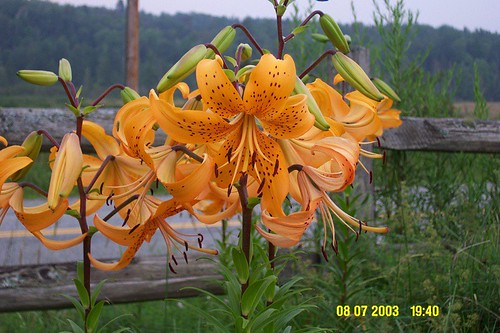tiger lily
(Lilium lancifolium)
Conservation • Description • Habitat • Ecology • Use • Distribution • Taxonomy
Conservation Status |
|
|||||||
| IUCN Red List | not listed |
|||||||
| NatureServe | NNA - Not applicable SNA - Not applicable |
|||||||
| Minnesota | not listed |
|||||||
Description |
||
Tiger lily is an erect perennial rising from a white, egg-shaped bulb. The stem is leafy, purplish, and densely covered with long, tangled, white hairs, especially near the top. The leaves are alternate, untoothed, and linear to narrowly lance-shaped. They are attached to the stem without a leaf stalk. They are held horizontally and droop at the tips. The margins have short, rounded, nipple-like bumps. The tips are densely covered with long, tangled, white hairs. The lower leaves are 4″ to 6″ long and have pointed tips. The upper leaves have rounded tips and rounded bases that partly surround the stem but do not fuse at the base. There are 1 to 3 small dark purple bulblets in the axils of the upper leaves. The bulblets can propagate the plant. The inflorescence is a terminal, branched, elongated, cluster of 3 to 6 flowers. The flowers hang downward at the end of stout, widely spreading flower stems. The large flowers are up to 4″ wide, Turk’s-cap shaped, and are not fragrant. They consist of 6 tepals, 3 inner tepals (petals) that are similar in appearance but slightly wider than the 3 outer tepals (sepals). The tepals spread outward and bend backward to their base. They are uniformly orange to reddish-orange with purple-brown spots except near the tips. The stamens project well beyond the tepals and curve widely outward. The fruit is a 3-celled seed capsule. The seeds are infertile. The plant reproduces from bulb scales and bulblets. |
||
Height |
||
3′ to 6′ |
||
Flower Color |
||
Orange to reddish-orange with purple-brown spots near the throat |
||
Similar Species |
||
Tiger lily is easily identified by its truly lance-shaped, alternate, widely sessile leaves and purple-black bulbils in the upper leaf axils. Michigan lily (Lilium michiganense) has a hairless stem. The leaves are whorled except near the top, where they are single, in pairs, or in partial whorls. The inflorescence is an umbel. The flowers are 2½″ to 3″ wide, reddish-orange with a yellowish-orange throat and purple or maroon spots near the throat. Orange daylily (Hemerocallis fulva) is shorter, 2′ to 4′ at maturity. It has a basal rosette of grass-like leaves and no leaves on the flowering stem. The flowers are funnel-shaped, tannish-orange with a yellow throat and a red stripe. They do not have spots. They are semi-erect or horizontal—they do not hang downward. They last only one day. Wood lily (Lilium philadelphicum var. andinum) is much shorter, 1′ to 3′ at maturity. The stem is hairless. The leaves are scattered, more or less alternate, except the uppermost, which are in a whorl. The inflorescence is an umbel. The flowers are 2½″ wide, widely bell shaped and erect—they do not hang downward. The tepals are spoon-shaped, clawed, erect, and flaring, and bend backward slightly toward their tips. The tips come to a blunt point. They do not touch near the base. They are bright orange or reddish-orange with a yellow throat and purple spots near the throat. |
||
Habitat |
||
Moist. Roadsides, railroad banks, near dwellings, yards. Partial sun. |
||
Ecology |
||
Flowering |
||
July to August |
||
Pests and Diseases |
||
|
||
Use |
||
|
||
Distribution |
||||
|
Sources Most sources show tiger lily to be rare in Minnesota, confined to just four counties in the state (dark green on the map). iNaturalist has observations throughout the state (light green on the map). The photos that accompany many of those observations clearly show the plant in a garden or other plantation—not outside of cultivation. GBIF also shows tiger lily throughout the state (also light green on the map). The counties in light green are believed to represent either misidentified Michigan lily plants or cultivated tiger lily plants. |
|||
| 6/28/2023 | ||||
Nativity |
||||
Native to China, Japan, and Korea. Introduced, cultivated, and escaped cultivation. Naturalized in eastern North America. |
||||
Occurrence |
||||
Uncommon in Minnesota Tiger lily is widely planted as an ornamental and sometimes escapes cultivation. |
||||
Taxonomy |
|||
| Kingdom | Plantae (Plants) | ||
| Division | Tracheophyta (Vascular Plants) | ||
| Subdivision | Spermatophytina (Seed Plants) | ||
| Class | Liliopsida (Monocots) | ||
Order |
Liliales (lilies, supplejacks, and allies) | ||
Family |
Liliaceae (lilies) | ||
| Subfamily | Lilioideae (true liliy) | ||
| Tribe | Lilieae (true lilies and allies) | ||
Genus |
Lilium (true lilies) | ||
Synonyms |
|||
Lilium tigrinum |
|||
Common Names |
|||
devil lily Easter lily lance-leaf tiger lily tiger lily |
|||
|
|||
The common name tiger lily is often applied to a number of other species of lily. However, that name properly applies only to this one. |
|||
Glossary
Axil
The upper angle where the leaf stalk meets the stem.
Bulbil
A small bulb, formed in a leaf axil or at the base of a stem, that can produce a new plant.
Claw
A stalk-like narrowed base of some petals and sepals.
Sepal
An outer floral leaf, usually green but sometimes colored, at the base of a flower.
Sessile
Stalkless; attached at the base without a petiole, peduncle, pedicel, or stalk.
Tepal
Refers to both the petals and the sepals of a flower when they are similar in appearance and difficult to tell apart. Tepals are common in lilies and tulips.
Umbel
A flat-topped or convex umbrella-shaped cluster of flowers or buds arising from more or less a single point.
Visitor Photos |
|||||
Share your photo of this plant. |
|||||
| This button not working for you? Simply email us at info@MinnesotaSeasons.com. Attach one or more photos and, if you like, a caption. |
|||||
|
|||||
MinnesotaSeasons.com Photos |
|||||
|
|||||

Visitor Videos |
|||
Share your video of this plant. |
|||
| This button not working for you? Simply email us at info@MinnesotaSeasons.com. Attach a video, a YouTube link, or a cloud storage link. |
|||
Other Videos |
|||
| Tiger Lily WildFilmsIndia |
|||
About
Published on Aug 26, 2014 The Tiger Lily, bears large, fiery orange flowers covered by spots. The name tiger probably refers to the spots on the petals. The flowers of this perennial can grow up to three inches in width. The Tiger Lily is also known as the Ditch Lily. The Tiger Lily has a strong, sweet and distinctively lily smell. Besides producing a stunning spectacle, most parts of this plant are edible. There are two varieties of the Tiger Lily: The Oriental Variety: Propagates through bulbs that form at leaf axils. The Common Wildflower Variety: Propagates by tuberous roots. The Tiger Lily is known by a host of different names in different parts of the world. Due to its wild growing nature, the Tiger Lily is incredibly easy to grow. Tiger lilies thrive well in moist to wet soils and hence grow well near the ditches. Early to mid-autumn is the best time to plant out the bulbs in cool temperate areas, in warmer areas they can be planted out as late as late autumn. The Tiger Lily is sterile and does not produce seeds. They can, however, be propagated through the bulbils (small bulbs) that grow in the axils of the leaves. Bulb scales can be removed from the bulbils and grown in moist peat in a cool dark place until they produce bulbets. They can be then grown in a nursery and later planted outside. Source: theflowerexpert.com This footage is part of the professionally-shot broadcast stock footage archive of Wilderness Films India Ltd., the largest collection of HD imagery from South Asia. The Wilderness Films India collection comprises of 50, 000+ hours of high quality broadcast imagery, mostly shot on HDCAM / SR 1080i High Definition, Alexa, SR, HDV and XDCAM. Write to us for licensing this footage on a broadcast format, for use in your production! We are happy to be commissioned to film for you or else provide you with broadcast crewing and production solutions across South Asia. We pride ourselves in bringing the best of India and South Asia to the world... Please subscribe to our channel wildfilmsindia on Youtube for a steady stream of videos from across India. Also, visit and enjoy your journey across India at www.clipahoy.com , India's first video-based social networking experience! Reach us at rupindang @ gmail . com and admin@wildfilmsindia.com |
|||
| Tiger Lily - Plants of the World oldstuff4all |
|||
About
Published on Sep 24, 2013 Tiger Lily is a lily from east of Asia. It's cultivated as an ornamental plant. |
|||
| "How to grow Tiger Lilies" Gardening 101 by Dr. Greenthumb EWarehouseOnline |
|||
About
Published on Jun 18, 2013 Play All http://bit.ly/14eapZs |
|||
| Lilium lancifolium Brent and Beckys Bulbs |
|||
About
Published on Jul 19, 2013 Brent takes a minute to stop and enjoy the Lilies in our Partier Garden and all of the butterflies that visit them! |
|||

Visitor Sightings |
|||||
Report a sighting of this plant. |
|||||
| This button not working for you? Simply email us at info@MinnesotaSeasons.com. Be sure to include a location. |
|||||
|
|||||
MinnesotaSeasons.com Sightings |
|||||
|
|||||

|
Created: Last Updated: © MinnesotaSeasons.com. All rights reserved. |


